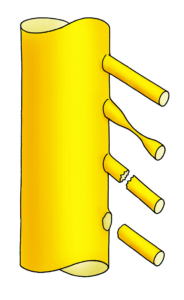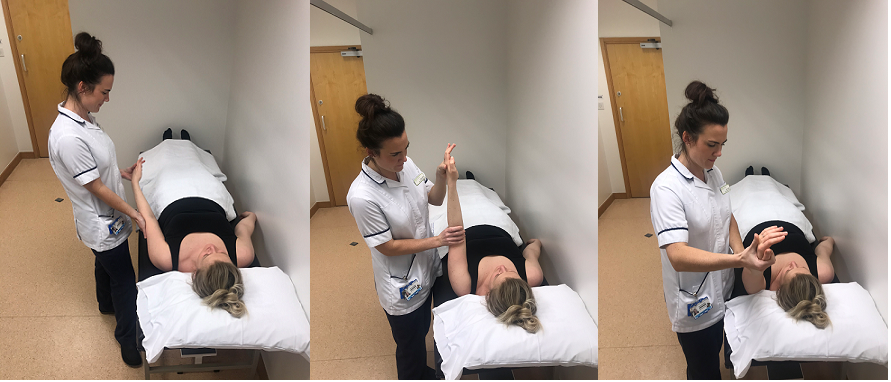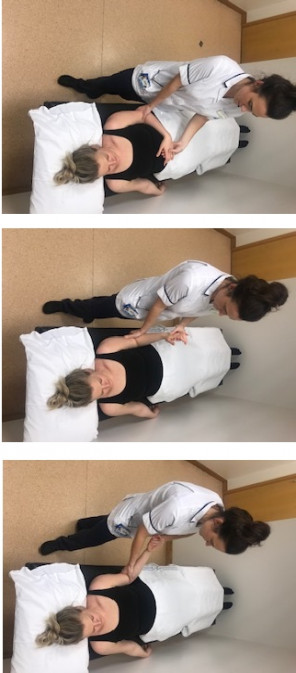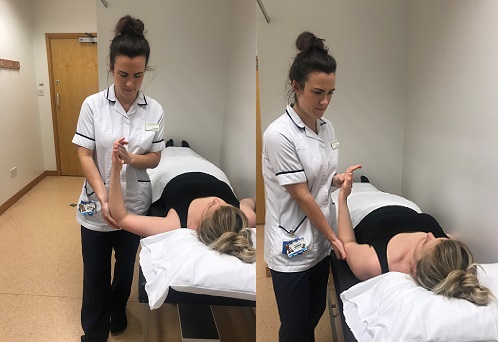On this page
What is the brachial plexus?
The brachial plexus (Plexus: Latin “braid”) is a network of nerves in the neck and shoulder region. They pass from the spinal cord in the neck, under the clavicle (collar bone) into the upper arm. These nerves carry electrical signals from the brain and the spinal cord, to the muscles and skin of the shoulder, arm and hand to provide movement and sensation (feeling) in your arm.
The plexus is formed by five nerve roots, which exit the spinal column in the neck, four named after the lower cervical (C) vertebrae (C5, C6, C7 and C8), and the fifth root from the first thoracic (T) vertebra (T1).
The roots join to form three trunks, the upper middle and lower trunk. Each trunk then divides into an anterior and posterior division. The divisions then join to form three cords, lateral, posterior and medial before finally splitting to form the major nerves of the arm.
These nerves enable the signals that allow movement and sensation to reach the arm. If any part of the path of the nerve is injured then signals from the brain will not reach the individual muscles in your arm and those muscles will not work.
How does the injury occur
In adults the commonest cause of injury is traction (stretching) of the brachial plexus usually sustained during a road traffic accident (RTA), mainly in motorcyclists. Occasionally damage occurs to the major blood vessels that carry blood to and from the arm.
Types of injury
There is a range of injuries to the nerves (roots, trunks or divisions) that can be produced by traction.
Minimally stretched with no structural damage (neurapraxia)
In this injury the sensitive nerve fibres temporarily stop working but will rapidly recover without surgery.
Stretched but remains intact
In this injury the nerve has been damaged but not torn apart. The nerves may recover to a variable degree on their own over a period of months and may not require surgical treatment.
Nerve Rupture
In this type of injury, the nerve has been stretched to breaking point and has been snapped or torn (similar to an overstretched elastic band). Ruptures will not heal without surgery.
Nerve Root Avulsion
In this injury, the nerves are torn away from the spinal cord and cannot be re-joined to the cord. Some function of the arm will be permanently lost. At surgery nerves may be transferred from other areas to improve function.

Assessment
After referral to our unit you will be assessed by medical staff either as an inpatient on the ward or in one of our outpatient clinics. We will examine your injury assessing your movement, power and sensation. We may also send you for tests which may include nerve conduction studies, MRI or CT scans.
What treatment will I receive after the assessment?
If the injury to the brachial plexus is mild and recovery is expected without surgery, then you will be seen in an outpatient clinic to support you and to review your progress.
If it is clear that rupture or avulsion has occurred, then surgical exploration and repair of these nerves may be offered.
How are nerves repaired?
In the commonest injuries, the nerves are torn or stretched and the damaged segment of nerve either side of the rupture must be removed and repaired. This is done using grafts of nerves from the legs and involves the need for nerve re-growth. Recovery can be lengthy and requires each individual microscopic nerve fibre reconnecting, making it unlikely for complete recovery.
Investigations
After assessment we may send you for one of the following tests, which will assist us with diagnosis and management of your injury:-
Nerve Conduction Studies – assess the speed of conduction of an electrical impulse through your nerves. This can help us with our clinical diagnosis of what damage may have occurred to your nerves.
MRI (Magnetic Resonance Imaging) scans – a type of imaging that uses magnets and radio waves to produce detailed two and three dimensional images of the inside of your body.
CT (computerised tomography) scans – use X-rays and a computer to create detailed images of the inside of your body.
Surgery
What happens if I need surgery?
If you are not already on the plastic surgery ward you will be given a date to come into hospital.
The Operation
All surgery is performed under a general anaesthetic. The surgeon will examine the nerves to establish the extent of the damage and whether repair is possible. If they find that the nerves have been ruptured (separated) then the gap between the nerves will be bridged by a nerve graft. These grafts may be taken from less important sensory nerves on the back of the legs or from nerves in the injured arm.
As your nerves start to recover you will need to work very hard at retraining them to move your arm and initially you may have to do different movements to make your arm work. The Physiotherapy team will guide you.
What will I be like when I return from theatre?
- You will have stitches or surgical clips on your neck and the back of your legs (if sural nerve grafts are used). These will be covered with dressings.
- You will have your arm strapped to your side or in a sling and this must stay in place without movement for four weeks.
- You may have a drain in place to remove any fluid from around the wound. This will usually be taken out after a few days.
How long will I have to stay in hospital?
Following your brachial plexus surgery you should only stay on the ward for a few days. This is dependent upon any other injuries you may have sustained at the time of your accident.
What follow up will I have?
One week following your operation:
- You will attend the dressing clinic and have your tape changed. At this stage any stitches that you have may be removed and your wound, arm and armpit cleaned.
- We will re-tape your arm.
Four weeks following your operation:
- You will be seen in the dressing clinic four weeks after your surgery to have the strapping or sling removed.
- You will see the physiotherapist to start passive exercises on your arm.
Three months following your operation:
- You will be seen in a multidisciplinary team clinic. This will allow you to discuss with the team how you are managing following your injury. Following this your progress will be monitored regularly in a brachial plexus practitioner clinic by a specialist physiotherapist. There may be a need to have an additional operation in the future and this will be discussed with your consultant at that stage.
Therapy Exercises
Passive exercises for the shoulder – only start these exercises when advised to do so by your physiotherapist. You may need assistance from a friend or family member to perform these exercises especially if your whole arm is affected.
Shoulder Flexion

Shoulder External rotation

Shoulder Abduction

Clinical Psychology
Brachial Plexus Injuries can have a huge impact on people’s lives and you may go through a range of emotional and physical symptoms after sustaining this type of injury.
The psychologists in the team are all used to seeing people who have sustained a brachial plexus injury and understand that it takes time to adjust.
Psychologists can usually help with specific techniques aimed to help with symptoms that you may be experiencing.
Living with a Brachial Plexus injury video
Living with Brachial Plexus Injury
In 2013, I had a motorcycle accident where I collided with a tractor. At the time of the injury, I was 18 years old. I was at college training to be a mechanic. I used to love going out on my motorcycle and going out with my friends. When I had my accident, I was taken to York District Hospital, where they treated me for my dislocated right elbow and my broken left hand. They found out that I had a brachioplexus injury and then transferred me over to Leeds, but at the time, I didn’t really know what was going on. I didn’t have any understanding of why my arm wouldn’t move when I came to LGI. This was all explained to me. I had really bad pain in my left arm and, like, to the point where I couldn’t do anything; it was just tense all the time. Red fingers curled up. I could just move these two fingers slightly.
When I came to the hands unit at LGI, I realized that I was in the right hands because I was actually talking to people who knew about my injury and understood why I couldn’t move it and why I was in the pain I was in. I was introduced to Miss Burke and the physiotherapist at Leeds Hospital, who then explained to me how serious my injury was and what it actually was and what it meant. They talked to me about surgery and stuff they could do to possibly help me. I was really getting down and fed up with my injury from the pain of not being able to move it, not being able to do anything, not being able to take part in stuff. I guess the pain was dragging me down. I was scared about getting a job and not being able to work, as I was training to be a mechanic at the time at college, but the use of my arm basically meant that I couldn’t do that any more. While I was waiting for the recovery in my arm, the physios taught me how important it was to keep my arm moving, keep the muscles fluid, and keep the joints moving. I had surgery to explore my left brachial plexus in 2013.
So, by June 2014 I’d started to see some recovery in my arm and was able to slightly lift another slight lifting motion I had physio and hydrotherapy which helped me a lot gained strength in my arm and the physios were really good pushing me and pushing me to get more out there I did hydrotherapy as well which was a group so it was quite good to speak to other people and help each other through the times of the injury and actually managed to talk me through it and guide me all the way through I suppose like just someone to talk to about it about my life as well as my injury about how I was going to get around stuff and that’s, but they said I had a positive attitude towards it which could help me crack on and get back to work and realize that life hasn’t actually grown to an all, and you can go further I can’t do some of the things I used to be able to do, but I found a way around everything by January 2015.
All my nerve transfers had started to show progress and was starting to give me different movements in my arm I just started to work on the strength and progression of those I now have a partner and a family and got a little cleaning job got me started then I’ve got a more permanent job window cleaning, and I’ve now been doing that for five years I do every day I still have bad days in my pain where I can’t go in but still with all the normal job I really wanted to get back on my bike and everyone said that I wouldn’t, or I couldn’t, and I shouldn’t, but that’s what I wanted to do so that’s what I did after about two and a half years I managed to start riding a bike again slowly, and now I can just do everything what my friends can do, and I’ve got a balance to my life and my injury and like I probably could get a little bit more out of my arm, but I don’t really have time because I’ve got a life I’ve got schedule kids in a job, so I’ve found a balance where I can cope we’ve been like this for the rest of my life and still live a decent lifestyle.